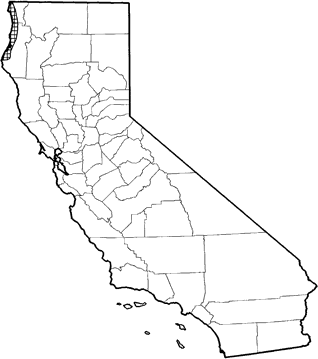
Townsend's Mole
Distribution, Abundance, and Seasonality
Townsend's mole is found along the North Coast in Del Norte and Humboldt cos., from the Oregon border south through about two-thirds of Humboldt Co. Optimum habitats are annual grassland, wet meadow, and early seral stages of redwood, Douglas-fir, mixed conifer, and montane hardwood-conifer forests. Townsend's mole in California mainly is a species of lowland river bottoms.

Range Map
Specific Habitat Requirements
Feeding: Earthworms comprise 55-86% of the diet, with the remainder insects, seeds, roots, leaves, slugs, snails, and small mammals (Wight 1928, Moore 1933, Pedersen 1963, Whitaker et al. 1979). Forages beneath the surface in light, base-rich soils.
Cover: This mole is almost entirely subterranean, spending its time in underground burrow systems. Requires well-drained, friable soil for burrowing.
Reproduction: Nests in a grass-lined cavity 15-20 cm (6-8 in) below the surface. Nests sometimes are placed under "fortresses" (large mounds of earth 75-125 cm (30-50 in) in diameter), or near the center of a cluster of several normal-sized mounds (Kuhn et al. 1966, Maser et al. 1981).
Water: Water needs are met from the diet, especially from earthworms.
Pattern: Prefers well-drained, friable soils. Avoids dense woods and thickets. Clearing, draining, and fertilizing of cropland and pasture may have increased numbers of Townsend's mole. In agricultural lands, nesting sites may be located along fences or near trees to avoid disturbance by cattle and plows.
Species Life History
Activity Patterns: Yearlong nocturnal activity. May be found above ground at night.
Seasonal Movements / Migration: May make short movements away from seasonally flooded areas.
Home Range: Home range averaged 0.17 ha (0.42 ac), varying from 0.003-1.04 ha (0.007-2.58 ac) (Giger 1973).
Territory: Adult home ranges do not overlap except during mating. Townsend's mole is aggressive in captivity (Giger 1973), and probably defends its burrow system against intruders. Populations occur in isolated patches, or colonies (Dalquest 1948).
Reproduction: Mating occurs in February and March, and the young are born in March and April after a gestation period of about 1 mo. Litter size averages 3 (range 2-4) (Larrison 1976) and there is 1 litter per year.
Niche: Townsend's mole is sympatric with the coast mole, which prefers drier soil and can be found in dense thickets. These species may be competitors in some areas. Predators include barn owls, rubber boas, dogs, cats, weasels, and skunks.
Sources & References
California Department of Fish and Game, 1999.
California's Wildlife, Sacramento, CA.
Written by: G. Hoefler, J. Harris, reviewed by: H. Shellhammer, edited by: S. Granholm
Dalquest, W. W. 1948. Mammals of Washington. Univ. Kans. Publ., Mus. Nat. Hist. 2:1-444. Giger, R. D. 1965. Surface activity of moles as indicated by remains in barn owl pellets. Murrelet 46:32-36. Giger, R. D. 1973. Movements and homing in Townsend's mole near Tillamook, Oregon. J. Mammal. 54:648-659. Kuhn, L. W., W. Q. Wick, and R. J. Pedersen. 1966. Breeding nests of Townsend's mole in Oregon. J. Mammal. 47:239-249. Larrison, E. J. 1976. Mammals of the northwest. Seattle Audubon Soc., Wash. 256pp. Maser, C., B. R. Mate, J. F. Franklin, and C. T. Dyrness. 1981. Natural history of Oregon coast mammals. Pac. Northwest For. And Range Exp. Sta., USDA, For. Serv., Gen. Tech. Rep., PNW-133. 496pp. Moore, A. W. 1933. Food habits of Townsend's and coast moles. J. Mammal. 14:36-40. Moore, A. W. 1939. Notes on the Townsend's mole. J. Mammal. 20:499-501. Nowak, R. M., and J. L. Paradiso. 1983. Walker's mammals of the world. 4th ed. 2 vols. John Hopkins Univ. Press, Baltimore, MD. 1362pp. Pedersen, R. J. 1963. The life history and ecology of Townsend's mole, Scapanus townsendii (Bachman) in Tillamook Co., Oregon. M.S. Thesis, Oregon State Univ., Corvallis. 66pp. Whitaker, J. O., Jr., and C. Maser, and R. J. Pedersen. 1979. Food and ectoparasitic mites of Oregon moles. Northwest Sci. 53:268-273. Wick, W. Q. 1962. Mole and gopher control. Oregon State Univ. Coop Ext. Serv., Bull. No. 804. 16pp. Wight, H. M. 1928. Food habits of Townsend's mole, Scapanus townsendii (Bachman). J. Mammal. 9:19-23.
California Animal Facts | California's Wildlife